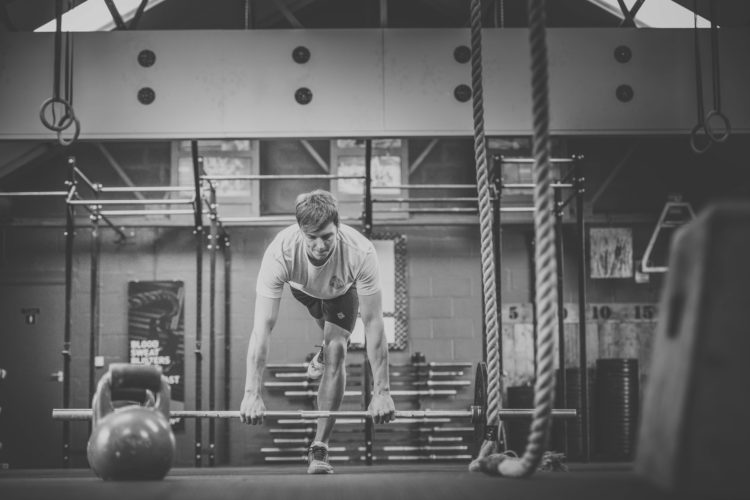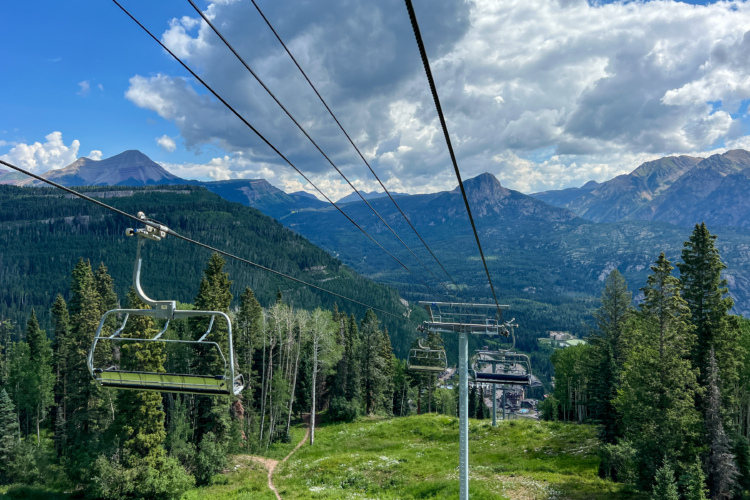
Is there anything quite as deadening as a long mountain bike ride? You know the feeling: weak, heavy legs. Hammered hands and sore triceps. An unquenchable thirst and the appetite of a black bear. Rarely does another workout give you the “hit by a bus” feeling that mountain biking can.
It might feel like that’s the only workout your body needs, not only to survive but to thrive. When it comes to a sustainable, low-impact activity that’s great for your cardiovascular health and fitness, metabolism and mental health benefits, you’d be right. But when it comes bone health and even enhancing your capability as a mountain biker, there is a lot of evidence that points to it’s wise to supplement your mountain biking with weight lifting and resistance training.
Evidence has only continued to show that athletes who only engage in cycling and not any weight bearing activities are at risk for bone mineral density and other bone issues. But if you’re like biochemical exercise physiologist, mountain biker and Singletracks contributor Jenny Corso, you understand the benefits of adding strength training or even running go far beyond just bone health.
Why mountain bikers should lift weights
One of the biggest benefits to mountain bikers who spend time training in the gym with resistance equipment is power output and being able to spin up a steep climb or hop up a rocky ledge.
“Think about it as what’s lacking without lifting,” said Corso “It’s like, bone mass suffers, posterior/anterior imbalance, power output, finding a good power to weight ratio and making sure you’re eating enough for all that and doing the right type of lifting.”
Arizona, where Corso resides, is full of some of the most technical and physical riding in the country, with staircases of rock up and down, and countless dirt-to-rock transitions that require a powerful burst from the legs or upper body to clear your front wheel. But there is plenty of technical terrain all over the country where having power built in the gym pays off.
“Riding at Gooseberry Mesa or places where you have to power up slickrock or anything technically up, you have to be able to pull your body and bike and maneuver yourself,” said Corso.
She adds, “If you don’t work on gaining the strength to do that, it’s going to be challenging if not impossible to do.”
For Braydon Bringhurst, the explosive mountain biker who scatters up some of the most technical and rocky trails around on video, he credits his experience as a collegiate athlete as being vital for his professional mountain bike career and trains with plyometrics and fast, powerful movements.
“What I’ve found is that it’s so important to get the most out of the muscles you do have rather than putting on mass and more muscles,” he told us in a 2021 interview. “Very often I’ll do weights that are pretty light and I’ll move them at a swift speed, and I’ll supplement that with depth jumps or box jumps or whatever and that maintains my explosiveness.”
Corso also argues that alternative exercises are necessary for proper muscular balance. Mountain biking is primarily an anterior muscle-dominant exercise, requiring more strength from your quadriceps and chest, and ignoring posterior muscle groups like the hamstrings and back.
“You see a lot of imbalance in cyclists in particular because they’re in one position, right? It’s way worse in road cycling.”

Building better bones
Where weight lifting, running, or participating in weight-bearing, impacted exercises becomes more important than even building power, is maintaining a healthy bone mineral density (BMD). And for a sport where we all risk fracturing bones, taking on other forms of exercise might be exactly what we all need to keep us on the trail.
Unfortunately, study after study shows that cyclists have some of the worst BMD of any athletes, although mountain bikers might hold an advantage compared to some other cycling disciplines.
“Ostopenia is not uncommon to see in cyclists that are 40-50 years old if they only cycle and they don’t do anything else,” said Corso. “Even in mountain biking, because we have suspension and it’s still a non-impacted exercise.”
While not as bad as osteoporosis, ostopenia is where the bones are weaker than normal, though not to the point of where they break very easily, according to WebMD.
Mostly the issues have been studied extensively in road cyclists, where riders are often on a smooth, paved surface in the seated position for hours on end, and sweating a lot, risking the additional loss of calcium.
“(Researchers at the University of Colorado Anschutz Medical Campus) discovered the competitive cyclists’ BMD decreased at a rate similar to that of post-menopausal women whose loss of estrogen accelerates bone loss and risk of osteoporosis. It was the first evidence researchers have seen showing that exercise can sometimes hurt rather than help the skeletal system.”
While many of the studies about BMD have involved professional-level cyclists who spend hours upon hours riding, it seems clear that riders who don’t engage in any forms of weight-bearing exercise are more at risk for bone density issues.
A 2013 study by Christopher D. Mojock on bone density in cyclists sent by Corso for us to review also stated the paradox of biking as primary fitness modality.
“The results of our study suggest that while cycling is beneficial to cardiovascular, pulmonary and metabolic health outcomes, bone does not respond in the same favorable manner. Although there was no difference in BMD between the trained and recreational cyclists, both groups had lower than normal BMD. Of most concern was the high prevalence of osteopenic and osteoporotic BMD at the lumbar spine.”
The study also indicated that trained cyclists with a high-volume of riding have a lower BMD that athletes who ride at a lower volume.

Differentiating mountain biking from cycling
It appears only one study has examined the differences between the bones of road and mountain bikers. The results are interesting and give another reason to get away from the cars and onto the trails.
In this study, 14 road riders and 16 XC mountain bikers who had been training at least 10 hours per week and 10 months per year for at least three years were included. Anyone who had engaged in weight training in the previous three years was excluded.
A control group who rode less than two hours per week and lifted for less than one hour per week for the prior three years was also included.
Participants underwent questionnaires and blood collections, bone density measurements, leg extension strength tests, peak oxygen uptake tests and more.
“The mountain cyclists had significantly higher BMDs at all sites measured when compared with the road cyclists and controls,” wrote the researchers after reviewing the results.
“The terrain and physical challenges inherent to cross-country mountain cycling are considered much more demanding and variable than those incurred in road training and racing.”
Where cycling is clearly non-weight-bearing is when a rider is in the seated position and much of their weight is suspended at the saddle. During descents, road cyclists remain in the saddle though while mountain bikers have to stand up to maintain control of the bike over obstacles.
“Studies of mountain cycling have revealed that 70% of the rider’s body weight is on the pedals while coasting, and this increases to 90% during downhill standing.”
“Thus, the differences in the demands of these two types of cycling (road and mountain) likely result in loading patterns that uniquely influence the skeleton.”
The study admits its limitations in that the mountain bikers were younger than the roadies and only males were studied, but it’s also another point for mountain biking. The mountain bikers’ BMDs were better than road cyclists that the study examined, but didn’t necessarily say that their BMDs are in an optimal range.
These results also provide some food for thought. If mountain biking with a more impacted nature provides a better response for BMDs than road cycling, then it’s safe to say that drop bar under-bikers have the best advantage followed by hardtail riders who only have suspension up front.
Ultimately though, if you’re young and can stand up to the punishment, freestyle and street BMXing probably take the cake.
Don’t take chances
Mountain biking does result in better overall bone mineral density than road cycling alone. If you’re regularly riding technical terrain then it’s probable that you’ll have better strength too, but it is still unclear from the one available study if mountain biking is enough to maintain a healthy BMD, and riders can still benefit from exercising their posterior muscles too.
“You can help that with three days a week with 20 minutes of lifting, focusing on those muscle groups,” in the posterior chain, like back, hamstring and core, said Corso. And in the last article we spoke to her for, running is one of the best exercises you can supplement your workouts with when it comes to positive benefits for bone health.
There’s at least a chance also that if you’re a mountain biker in the summer, you’re a skier or snowboarder in the winter; also a great activity for building bone density according to this study.
Corso adds you don’t have to go too heavy when it comes to lifting. Find a routine that works best with your body and your goals. In the end, it should only enhance your fitness level for mountain biking.
“If I had to give anybody a recommendation on what type of lifting or strength training to do to complement mountain biking, it would be to stick with Olympic style strength training and cap yourself on a certain amount of weight that just enhances your mountain biking.”











6 Comments
Mar 8, 2024
Mar 9, 2024
With my current vocation, the "gym" pays me instead of me paying a gym. Not too shabby.
Mar 14, 2024
Now if you riding say hard pack fairly smooth trails you will not get that upper body workout like on those technical climbs and some weights maybe helpful .
Mar 11, 2024
Mar 8, 2024
Also, on my first read of the word 'alone' in the title I took it to mean by oneself rather than solely. :) I think both are true, that if you mountain bike by yourself all the time you're unlikely to get into peak shape. Riding with others will push you harder than you push yourself. Cross training + riding with others = superhero trail fitness.
Mar 14, 2024